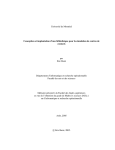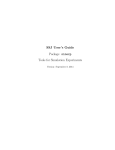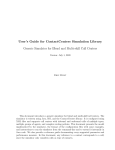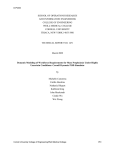Download user`s guide - Recherche : Service web
Transcript
Java Call Centers Optimization Library
Installation and User’s Guide
Package : umontreal.iro.lecuyer.ccoptim
Laboratoire de Simulation
Chaire de Recherche du Canada en Simulation et Optimisation Stochastiques
DIRO, Université de Montréal
November 20, 2006
Contents
1
Contents
1
Introduction . . . . . . . . . . . . . . . . . . . . . . . . . . . . . . . . . . .
2
2
Installation . . . . . . . . . . . . . . . . . . . . . . . . . . . . . . . . . . .
3
3
Program Setup . . . . . . . . . . . . . . . . . . . . . . . . . . . . . . . . .
3
3.1
Windows 95/98/Me . . . . . . . . . . . . . . . . . . . . . . . . . . . . . . .
4
3.2
Windows 2000/XP . . . . . . . . . . . . . . . . . . . . . . . . . . . . . . .
4
3.3
Linux/Unix . . . . . . . . . . . . . . . . . . . . . . . . . . . . . . . . . . .
4
4
Running the Optimization Programs . . . . . . . . . . . . . . . . . . . . .
5
4.1
Cutting Plane Optimizer . . . . . . . . . . . . . . . . . . . . . . . . . . . .
5
4.2
Randomized Search . . . . . . . . . . . . . . . . . . . . . . . . . . . . . . .
6
5
Parameter Files . . . . . . . . . . . . . . . . . . . . . . . . . . . . . . . . .
6
5.1
Call Center Parameter File . . . . . . . . . . . . . . . . . . . . . . . . . . .
7
5.2
Simulator Parameter File . . . . . . . . . . . . . . . . . . . . . . . . . . . .
7
5.3
Cutting Plane Optimizer Parameter File . . . . . . . . . . . . . . . . . . .
8
5.4
Randomized Search Parameters . . . . . . . . . . . . . . . . . . . . . . . . 12
5.5
Loss Delay Approximation Parameters . . . . . . . . . . . . . . . . . . . . 15
2
1
1 Introduction
Introduction
This document is a short user’s guide for a staffing optimization program for multiskill call
centers. It includes two differents optimization programs : a cutting plane algorithm based
on simulation and linear programming [4] and a randomized search using approximations
[1], both developed in the simulation laboratory of DIRO, under the Canada Research
Chair in Stochastic Simulation and Optimization.
In a staffing problem, a multiskill call center is composed by multiple agent groups
and different call types. A call requires the appropriate skill in order to be served. Agents
of the same groups share an identical skills set and the cost an agent depends on his group
(skills set).
The objective is to minimize the staffing cost while satisfying the service level (SL)
targets. The service levels taken into account in our problem are defined as the proportion
of calls having waited less than awt time, where awt is called the acceptable waiting time.
Many variants of the service level formula exist, the user must assure than the desired
formula is available in the call center evaluator library to be given to the optimization
programs.
To formulate as a mathematical problem, we have : a set M = {1, 2, . . . , m} of agent
groups and a set N = {1, 2, . . . , n} of call types, the cost vector c = (c1 , . . . , cm ) and
staffing vector x = (x1 , . . . , xm ). The service levels are complex functions, denoted as
g(x) or gk (x) for call type k, that are approximated by simulations or analytically. The
solution is constrained to satisfy the service level targets l for the global target and per
call type target lk for each k ∈ N . We obtain the integer problem :
min cT x =
m
X
ci xi
i=1
subject to :
g(x) ≥ l
gk (x) ≥ lk ,
∀k ∈ N
x ≥ 0 and integer
In the current version, the programs are developed on Sun Microsystems’ Java 5. The
programs use the ContactCenters : Java library for simulating contact centers [3], developed in the same laboratory by Eric Buist, the simulation library SSJ [7], the scientific
library colt [5] and also implementation to support libraries for linear optimization li-
3
braries OR-Objects 1.2.4[8] and Cplex [6]. The linear optimization library OR-Objects
1.2.4[8] is freely available.
This guide contains informations for the installation under the Windows and Linux
operating system and for the usage of the staffing optimization programs. It explains what
needs to be installed, how to run the program, the description of each input parameter
file.
It is recommended to consult the detailed guides describing the simulation programs
and the XML parameters, written by Eric Buist. The details of the optimization algorithm
are described in Cez̧ik and L’Ecuyer [4] and Avramidis et al. [2]. It explains the choice
and reason of the values given to some parameters of the algorithm, principally for the
cut generation.
2
Installation
The current version of the optimization programs are developed on Sun Microsystems’
Java 5. A version of Java 5 is required for the execution of the programs. If one doesn’t
need to compile the programs, the Java Runtime Environment (JRE) is sufficient, otherwise installs the Jave Development Kit (JDK). For linear optimization library, the user
must assure the proper installation of their library such as Cplex [6]. Note that for
OR-Objects 1.2.4 no installation is required.
A copy of the ContactCenters, SSJ and colt are included in the distribution, and no
executable installation is required.
3
Program Setup
The following Java archives (jar), included in the distribution, are required for the optimization programs to run: ccoptim.jar, ssj.jar, contactcenters.jar, colt.jar.
The jar need to be declared in the system environment variable CLASSPATH.
Additionnal steps would be required to setup the linear optimization library. If using
OR-Objects 1.2.4, or124.jar must also be included in the CLASSPATH. If using Cplex,
cplex.jar must also be included in the CLASSPATH. We suggest the user to consult their
user’s manual for an appropriate setup of their libraries.
Note: To use the pre-implemented solver interfaces with Cplex 8, Cplex 9 or ORObjects 1.2.4, the folder lib must be added to the CLASSPATH.
4
3 Program Setup
3.1
Windows 95/98/Me
Suppose, for example, that the folder lib has been copied to the directory C:\ccoptim\lib.
Then the next step is to set the CLASSPATH variable. Open a text console and type in a
single line:
set CLASSPATH =% CLASSPATH %; C :\ ccoptim \ lib \ ccoptim . jar ;
C :\ ccoptim \ lib \ ssj . jar ; C :\ ccoptim \ lib \ colt . jar ;
C :\ ccoptim \ lib \ contactcenters . jar ; C :\ ccoptim \ lib
It would be preferable to insert the line in the file C:\autoexec.bat if C: is the system
drive.
3.2
Windows 2000/XP
Suppose, for example, that the folder lib has been copied to the directory C:\ccoptim\lib.
Then the next step is to set the CLASSPATH variable.
1. Right-click on My Computer and select properties.
2. Select the tab Advanced and click on the button named Environment Variables.
3. If a variable named CLASSPATH already exists, select it and click on Edit, otherwise,
click on New and type CLASSPATH as the Variable name.
4. In Variable value, add the location of each jar separete with a colon ”;”. Such as,
C:\ccoptim\lib\ccoptim.jar;C:\ccoptim\lib\ssj.jar; C:\ccoptim\lib\colt.jar;
C:\ccoptim\lib\contactcenters.jar; C:\ccoptim\lib
3.3
Linux/Unix
Suppose, for example, that the folder lib has been copied to the directory
/home/username/ccoptim/lib.
The user need to define the CLASSPATH environment variable if not already defined
and :
• Using C-shell, add to file .cshrc in one line :
setenv CLASSPATH / home / username / ccoptim / lib / ccoptim . jar :
/ home / username / ccoptim / lib / contactcenters . jar :
/ home / username / ccoptim / lib / colt . jar :
5
/ home / username / ccoptim / lib / ssj . jar :
/ home / username / ccoptim / lib : $CLASSPATH
• Using Bourne shell, add to file .bashrc in one line :
export CLASSPATH = $ { CLASSPATH }:
/ home / username / ccoptim / lib / contactcenters . jar :
/ home / username / ccoptim / lib / colt . jar :
/ home / username / ccoptim / lib / ssj . jar :
/ home / username / ccoptim / lib / ccoptim . jar :
/ home / username / ccoptim / lib
4
Running the Optimization Programs
Since the CLASSPATH environment variable has been set, the programs can be executed in
any directory.
4.1
Cutting Plane Optimizer
The cutting plane optimization program needs 3 parameter files which will be detailed
along with examples in Section 5. It is important to setup the parameters accordingly to
obtain the best performance.
To open a text console in Windows, click on Start, Run and type ”cmd”.
Command line to run the program :
java umontreal . iro . lecuyer . ccoptim . cp . C u t t i n g P l a n e O p t i m i z e r ccParams . xml
simParams . xml cpParams . xml
where,
• ccParams.xml is the call center’s parameter file. It contains the descriptions of the
call center which includes the arrival rates, service rates, routing scheme, global
target service level and more.
• simParams.xml is the simulator’s parameter file. This file is used only by the simulator.
• cpParams.xml is the cutting plane optimization parameter file. The user can change
the cut generation rules, the type of cuts used and others options related to the
optimization. See Section 5.3.
6
5 Parameter Files
4.2
Randomized Search
The randomized search requires 4 parameter files which will be detailed along with examples in Section 5. It is important to setup the parameters accordingly to obtain the best
performance.
To open a text console in Windows, goto Start, Run and type ”cmd”.
Command line to run the program :
java umontreal . iro . lecuyer . ccoptim . rs . RandomizedSearch ccParams . xml
ldParams . xml simParams . xml rsParams . xml
where,
• ccParams.xml is the call center’s parameter file. It contains the descriptions of the
call center which includes the arrival rates, service rates, routing scheme, global
target service level and more.
• ldParams.xml is the loss-delay approximation parameter file.
• simParams.xml is the simulator’s parameter file. This file is used only by the simulator.
• rsParams.xml is the randomized search parameter file. The user can set different
multistarts position, a time limit to the execution and others options related to the
optimization. See Section 5.4.
5
Parameter Files
For XML files, the parameter tags are all described in their respective Java class parser.
Please look in the HTML API or PDF to find the complete list of parameters. A fully
detailed description on how to use the XML configuration files is available the guides
for the simulation and XML parameters. Some parameters are optional, if they are not
specified, the default values will be used, while others are essential parameters like the
arrival rates. If an essential parameter is missing, the program will terminate and print
an error requiring the missing parameter before starting the algorithm. The type of value
accepted by each parameter is the variable type described in the HTML API and PDF. It
can be a boolean (true or false), an integer (no decimal) or a real (number with decimals).
A parameter can also be an array of those 3 types.
To set a parameter, put the parameter name before and after the value.
5.1 Call Center Parameter File
7
Example : <verbose> true </verbose>
For an array, the values are separeted by a comma (”,”).
Example : <arrivalRates> 10, 9, 10 </arrivalRates>
To put comments in the XML file, surround the comments like this :
<!-- comments -->.
Example to put the changeHeuristicCut parameter in comment :
<!-- <changeHeuristicCut>true</changeHeuristicCut> -->
5.1
Call Center Parameter File
Both the optimizers and the simulation use the call center parameter file. A fully detailed
documentation on the available parameters can be found in the ContactCenters simulation library [3] and XML user’s guide. However for the optimizer to work, not every
parameter field is required to be filled. The documentation is available in the PDF file :
guidemsk.pdf of the ContactCenters simulation library.
5.2
Simulator Parameter File
The Java call center simulator also needs a parameter file to configure the simulation.
The parameters are described in the simulation and XML parameters user guide in the
section batchSimParams and common simulation parameters. These informations are
read only by the simulator and are never used by the optimizer. It would be important to
understand the function of some variables. The quality of the approximation by simulation
is dependent of the length of the time simulated. However, long simulation requires more
time. The length of the optimization program can be greatly affected by the time used
for simulations.
Again, here’s a short description for a few parameters, other parameters could be used.
For more details, please refer to the ContactCenters simulation user’s guide PDF.
• targetError (real) : the target relative error to adjust the simulation length dynamically. Set to -1 to disable this. We suggest -1 to control the simulation length
manually.
• level (real) : the level of confidence intervals when computing relative errors or
displaying statistical reports.
8
5 Parameter Files
• initNonEmpty (boolean) : if true, then indicates that the system will be initialized
with n × targetInitOccupancy agents busy and all queues empty, where n is the
total number of agents. We suggest true.
• batchSize (real) : batch size in simulation time units.
• minBatches (integer) : minimal number of batches. When simulation length adjustment is not used (targetError < 0), this corresponds to the number of simulated
batches. The total length of the simulation is batchsize×(minbatches+warmupBatches).
• warmupBatches (integer) : number of warmup batches to simulate before collecting
statistical observations.
Example of the simulator parameter file :
< batchSimParams
targetError = ”−1”
level = ” 0 . 9 5 ”
t a rg e t In i t Oc c u pa n c y = ” 0 . 9 ”
initNonEmpty = ” t r u e ”
batchSize = ” 10 ”
minBatches = ” 10 ”
warmupBatches = ” 2 ” >
</ batchSimParams >
Listing 1: Example of the simulator parameter file
5.3
Cutting Plane Optimizer Parameter File
The cutting plane optimizer parameter file is only used by the optimization program and
the documentation can be found in the class CuttingPlaneParams. Some parameters
are very technical and depend on the call center’s characteristics, they should be used by
users who understand the optimization algorithm. See the paper Cez̧ik and L’Ecuyer [4]
for details. The cost vector c can be set by defining the parameter busyCost for each
agent group in the simulator’s parameter file or by setting the skillCost parameter in
this file. Important parameters are followed by a “*”.
Here’s the description of each parameter :
• currentPeriod (integer) : select the period to optimize. The period count starts
with 0.
5.3 Cutting Plane Optimizer Parameter File
9
• skillCost (real) : If the parameter busyCost of an agent group in the simulator’s
parameter file is greater than zero (> 0), the cost per agent of that group is equal
to busyCost. Otherwise, the cost per agent of that group is defined as : 1 +
skillCost × (skill count − 1), where skillCost is this parameter.
• minEachQosH (real) : for the heuristic cut generation, if the QoS of a call type is
below this value, then that call type is subject to generate a heuristic cut, not based
on the subgradient. We suggest to set a low value (e.g.0.1).
• testConvexity (boolean) : if true, then the program will test the convexity of the
QoS function around the current staffing vector solution by testing one dimension
at a time with a length of defaultSubStep + 1. This adds more simulations and
this test is not needed for the optimization. It is only to check the convexity of the
problem. By default, set to false.
• errorOnConvexity (boolean) : if testConvexity is false, this option has no effect. If testConvexity is true and this is true, then whenever the program finds
a convexity region, it will throw an error and terminate. If false, then it will only
print a convexity warning message and continue the algorithm. By default, set to
false.
• cutPriority (integer) : if equals to 1, then, between a heuristic and a subgradient
cut, the priority goes to the subgradient cut. Otherwise, the priority goes to the
heuristic cut. Default value is 0 (heuristic cut).
• defaultSubStep* (integer) : the default step length used to compute the subgradient around the current staffing vector. Default value is 1, but should be set according
to the call center. It is recommended to set to ≥ 2, if using short simulations and
large call centers.
• lowOverallSubStep* (integer) : when the global QoS is lower than the pivotOverallQos
point, the algorithm uses this value to compute the subgradient instead of the
defaultSubStep. Default value is 2, it should be higher than defaultSubStep.
• pivotOverallQos (real) : if the global QoS is lower than this point, then the program will use lowOverallSubstep instead of defaultSubStep. This parameter is
used to reduce the noise of the simulation in convex region. The value should be
around halfway between 0 and the global target service level.
10
5 Parameter Files
• pivotPerCallQos (real) : if the global QoS is equal or higher than this value,
then the algorithm can choose to generate the subgradient per call type instead
of a subgradient for the global QoS when the QoS of call type doesn’t satisfy its
target QoS. This parameter is justified by the reason that improving a call type also
improves the global service level. However, we don’t want to start at the beginning
since the noise is higher per call type. The value should be close to the global service
level target.
• loadCoefficient* (array of real) : this is the coefficient that is multiplied to the
arrival rate when solving the minimum load problem. Default value is 1.0. These
values should varie with the blocking and abandon rates. Set it sligthly lower when
there is abandonment. This parameter is important to determine an initial starting
point where the service levels shouldn’t be too far in the convex region (very low
service levels). If the array has more elements than the number of call types (let’s
say m) , only the first m elements are used.
• changeHeuristicCut (boolean) : if true, then the program will follow the improvement resulted from a heuristic cut. If the last heuristic cut added brought a big
improvement to the QoS of the call type, it will change that heuristic cut to find
the right cut constraint so that the QoS of that call type is at minEachQosH. By
default, set to true.
• solverClass (string) : input the name (and package name) of the linear solver
interface class (without the suffix .class) to be used in the optimization. This
class is used by the optimizer to interact with existing linear solver libraries. The
currently implemented interfaces included as extra files are :
– umontreal.iro.lecuyer.ccoptim.cp.OR124Solver.class (OR-Objects 1.2.4)
– umontreal.iro.lecuyer.ccoptim.cp.Cplex8Solver.class (Cplex 8)
– umontreal.iro.lecuyer.ccoptim.cp.Cplex9Solver.class (Cplex 9)
Note: While OR-Object 1.2.4 is free but the implemented solver does not solve IP.
The user must install his copy of Cplex in order to use the Cplex solvers.
• solveIP (boolean) : depends on solverClass. If the solver can solve IP instance,
setting to true will enable to solve the IP instead of the LP. The setting also depends
on the difficulties of the problem. Solving the IP could take a high amount of time
in large size problems.
5.3 Cutting Plane Optimizer Parameter File
11
• solveWithMaxFlowCut (boolean) : If the service time distribution are independent
of the agent groups, the user can choose to add heuristic cuts based on a maxflow
subproblem. This parameter affects the heuristic used when the service levels are too
poor to generate subgradients. If false, a constant number of network flow equations are incorporated at the beginning of the problem. Solving with a maxflow
subproblem keeps the number of variables equal to the number of agents, but generating these heuristic cuts can be costly in large problems. When solving the the
network flow equations, a limited number of non-negative real variables are added
and the constraints are already known. By default, set to false.
• verbose (boolean) : if false, then the program will print only the simulation
results, the staffing vector, the objective value and the QoS for the optimal solution.
If true, then the program will also print a trace of every step of the algorithm, every
contraint added, intermediate staffing solutions, quality of service and the objective
value. By default, set to false.
< c ut ti ng Pl an eP ar am s
currentPeriod = ” 0 ”
skillCost = ” 0 . 0 5 ”
minEachQosH = ” 0 . 1 ”
testConvexity = ” f a l s e ”
errorOnConvexity = ” f a l s e ”
cutPriority = ” 0 ”
defaultSubStep = ” 2 ”
low Overal lSubSt ep = ” 3 ”
pivotOverallQos = ” 0 . 6 5 ”
pivotPerCallQos = ” 0 . 7 0 ”
ch an ge He ur is ti cC ut = ” t r u e ”
solveIP = ” f a l s e ”
solverClass = ” u m o n t r e a l . i r o . l e c u y e r . c c o p t i m . c p . O R 1 2 4 S o l v e r ”
s o lv e W it h M ax F l ow C u t = ” f a l s e ”
verbose = ” f a l s e ” >
< loadCoefficient >
< row repeat = ” 65 ” >1 </ row >
</ loadCoefficient >
</ cuttingPlaneParams >
Listing 2: Example of the cutting plane parameter file
12
5 Parameter Files
5.4
Randomized Search Parameters
This parameter file is only read by the randomized search program. It contains the
parameters that control the heuristic.
• n1 (integer) : element is the minimum number of skill groups with at least q (randomly generated number) agents to activate the remove algorithm of size q. We
suggest to set it to 1.
• n2 (integer) : element is the maximum test size desired. Which means that some
test candidates may not be evaluated. A test candidate is a skill group that can
reduce the staffing cost by changing its staffing. We suggest to set higher or equal
to the number of agent groups. It is preferable to evaluate every candidate.
• delta (real) : element is the ratio of the number of test candidates over n2 that
is added to the serie of tests. If it is set to 1.0, then it will test every candidates.
This value must be between 0 and 1, inclusively.
• findInitialStaffing (boolean) : element, if set to true, will generate automatically the initial staffing (with the parameters rootL and lowerCostRatio). If set to
false, then the program will use the staffing defined in the Call Center parameter
file as the initial solution. We suggest to set to true.
• opGlobalTargetServiceLevel (boolean) : element is the global target service level
used for the approximated values feasibility test if useLDOTargetServiceLevel is
set to true. The global QoS of the optimal solution computed by approximation
must be equal or greater than this parameter.
Note:This value is not used with the correction by simulations step. The target
service level used to test the feasibility of the simulations are in the Call Center
parameter file.
• opTargetServiceLevel (array of real) :array of elements that are the target service
level per call type used for the approximated values feasibility test. The array
contains a target service level for each call type. This is the corresponding parameter
of opGlobalTargetServiceLevel to the call types. The program will use these
values only if useLDOTargetServiceLevel is set to true. ATTENTION:This value
is not used with the correction by simulations step. The target service level used to
test the feasibility of the simulations are in the Call Center parameter file.
5.4 Randomized Search Parameters
13
• useBusyCost (boolean) : element represents the cost type for the agent groups. If
set to false, then the agent group cost is computed with the number of skills, which
is : 1.0 + (# of skills - 1) * skillPremiumCost. If set to true, then the program
will use the busy cost defined for each agent group in the Call Center parameter
file.
• skillPremiumCost (real) : element is the premium cost of an agent group for each
additional skill over 1.
• searchMode (integer) : enables the user to select the type of search : 0 for mix (mix
of remove and switch) or 1 for sequential (remove then switch). We suggest to set
it to 0.
• useSimRemove (boolean) : if set to true will execute the SimRemove procedure in
the correction by simulation phase. We suggest to set it to true.
• useSimSwitch (boolean) : if set to true will execute the SimSwitch procedure in
the correction by simulation phase. Because this procedure requires a huge amount
of time and the cost saved might not always be worth the extra time, we suggest to
set it to false. Set to true if time is not a constraint.
• maxRSCPUsec (int) : is the maximum number of seconds spent in search mode, this
does not include finding an initial staffing. Since the program doesn’t take hours to
finish, this parameter should be omitted. We suggest to set a high value.
• useRealTime (boolean) : if set to true will compute the execution time as the real
(world) time. If set to false, the program will compute the execution time as the
amount of time spent in the CPU (the CPU time). This value is used to truncate
the randomized search if the execution time goes above maxRSCPUsec.
• rootL (array of doubles) : is used to generate the initial staffing. It uses a rootsolver to find the number of agents for each skill group to satisfy the inflows with
a quality of service of rootL. The AWT is the same as declared in the Call Center
parameter file. Setting multiple values triggers a multi-start. We suggest a value
around the global service level target.
• lowestCostRatio (array of doubles) : represents the proportion of the inflow calls
that goes to the cheapest agent group that can serve call type. The rest are divided
equally to the other agent groups that can answer to that call type. If there is
only one agent group that can serve, then a ratio of 1.0 is automatically used.
14
5 Parameter Files
This parameter seems to have a bigger impact on the quality of the initial solution.
Setting multiple values triggers a multi-start. We suggest a value of 0.8.
• randomSeeds (array of integer) : contains the initial seed of the random number
generator used by the randomized search program, but not the simulation. This
program use the MRG32k3a generator which needs 6 integer numbers. If this parameter is omitted, then it will use the default values.
• verbose (boolean) : if set to true, prints the status of each iteration : cost, global
QoS, the staffing move, number of agents. If set to false, then only the final (after
simulation) staffing solution, the staffing cost and the QoS are printed.
Here’s an example of the parameter file for the optimizer :
< randomizedSearchParams
n1 = ” 1 ”
n2 = ” 10 ”
delta = ” 1 . 0 ”
verbose = ” t r u e ”
f i nd I n it i a lS t a ff i n g = ” t r u e ”
opGlobalTargetServiceLevel =” 0 . 8 ”
simPriority = ” 1 ”
useBusyCost = ” f a l s e ”
skillPremiumCost = ” 0 . 0 5 ”
searchMode = ” 0 ”
useSimRemove = ” t r u e ”
useSimSwitch = ” f a l s e ”
maxRSCPUsec = ” 3 0 0 0 0 0 0 0 0 ”
useRealTime = ” f a l s e ”
useLDOTargetServiceLevel =” f a l s e ” >
< opTargetServiceLevel >
0.8 , 0.8 , 0.8 , 0.75 , 0.6 , 0.6 , 0.6
</ opTargetServiceLevel >
< rootL > 0.8 </ rootL >
< lowestCostRatio > 0.5 </ lowestCostRatio >
< randomSeeds > 19992 ,6210 ,1414 ,595 ,56558 ,2146 </ randomSeeds >
</ randomizedSearchParams >
5.5 Loss Delay Approximation Parameters
15
Listing 3: Randomized Search parameters
5.5
Loss Delay Approximation Parameters
This file contains all the configuration variables for the Loss Delay approximation program.
It approximates the performance levels of a multi-skill call center of a staffing vector for a
single period. If the user only wants to approximate the performance of a staffing vector,
this vector must be defined in the Call Center parameter file, see Section 5.1.
• currentPeriod (integer) : specifies the period to approximate. It is important to
select the right period. Period 0 corresponds to the first period of the Call Center
parameter file.
• maxIteration (integer) : sets the maximum number of iterations to execute while
waiting for convergence of the approximation. If the values don’t converge, the
program returns ”non-convergent”, which means the convergence failed. This parameter affects directly the speed of the program. We suggest a value of 400.
• absErrorTolerance (double) : represents the convergence test value. It is the
minimum accepted difference for a performance measure between two iterations.
The program iterates until every performance measure (choosen with the parameter
accuracyType) satisfies this tolerance. A big value (ie: 0.01) would diminish the
quality of the approximation. We suggest a value of 1e-4 (or 10−4 ).
• accuracyType (integer) : represents the type of convergence to test. If set to 1,
then the convergence is tested on the blocking probability of each skill groups. Else
if set to 2, the convergence is tested on the inflows of each skill groups. We suggest
to set it to 1.
• queueAbandon (boolean) : should be set according to the possibility of abandonment. Set to false if there are no abandonment. This parameter decides on the
CTMC to be used to estimate the blocking and queueing probabilities.
• queueCapacity (integer) : set the queuing length at each agent group. This parameter is only needed when queueAbandon is true. Setting to < 0 for automatic
√
selection rule which is : δ m, where m is the number of agents in the group and δ
is the defined by the parameter delta. We suggest to set to -1.
16
REFERENCES
• delta (double) : is used compute the queue length when queueCapacity is true,
otherwise it is ignored. See the parameter queueCapacity. We suggest a value of
2.
• debug (boolean) : if set to true, prints out the unstable skill group (when the
queues are unstable). We suggest to set it to false.
• verbose (boolean) : if set to true, prints out at each iteration. Set if to false, the
program doesn’t print while in the randomized search.
Here’s the parameter file for the Loss Delay approximation :
< lossDelayParams
currentPeriod = ” 0 ”
maxIteration = ” 400 ”
abs ErrorT oleran ce = ” 1 e −4”
accuracyType = ” 1 ”
queueAbandon = ” t r u e ”
queueCapacity = ”−1”
delta = ” 2 ”
debug = ” f a l s e ”
verbose = ” f a l s e ” / >
Listing 4: Loss Delay approximation parameter file
References
[1] A. N. Avramidis, W. Chan, and P. L’Ecuyer. Staffing multi-skill call centers using a
performance approximation and search methods. Manuscript, 2006.
[2] A. N. Avramidis, W. Chan, and P. L’Ecuyer. Staffing multi-skill call centers via search
methods and a performance approximation. Manuscript, 2006.
[3] E. Buist and P. L’Ecuyer. ContactCenters: A Java Library for Simulating Contact
Centers, 2005. Software user’s guide, forthcoming.
[4] M. T. Cez̧ik and P. L’Ecuyer. Staffing multiskill call centers via linear programming
and simulation. Management Science, 2006. To appear.
[5] Wolfgang Hoschek. The Colt Distribution: Open Source Libraries for High Performance Scientific and Technical Computing in Java. CERN, Geneva, 2004. Available
at http://dsd.lbl.gov/~hoschek/colt/.
REFERENCES
[6] ILOG inc.
17
Ilog cplex, 2006.
Optimization library. See http://www.ilog.com/
products/cplex/.
[7] P. L’Ecuyer. SSJ: A Java Library for Stochastic Simulation, 2004. Software user’s
guide, Available at http://www.iro.umontreal.ca/~lecuyer.
[8] DRA Systems. Or-objects 1.2.4, 2000. Java mathematic library. Available at http:
//opsresearch.com/.























